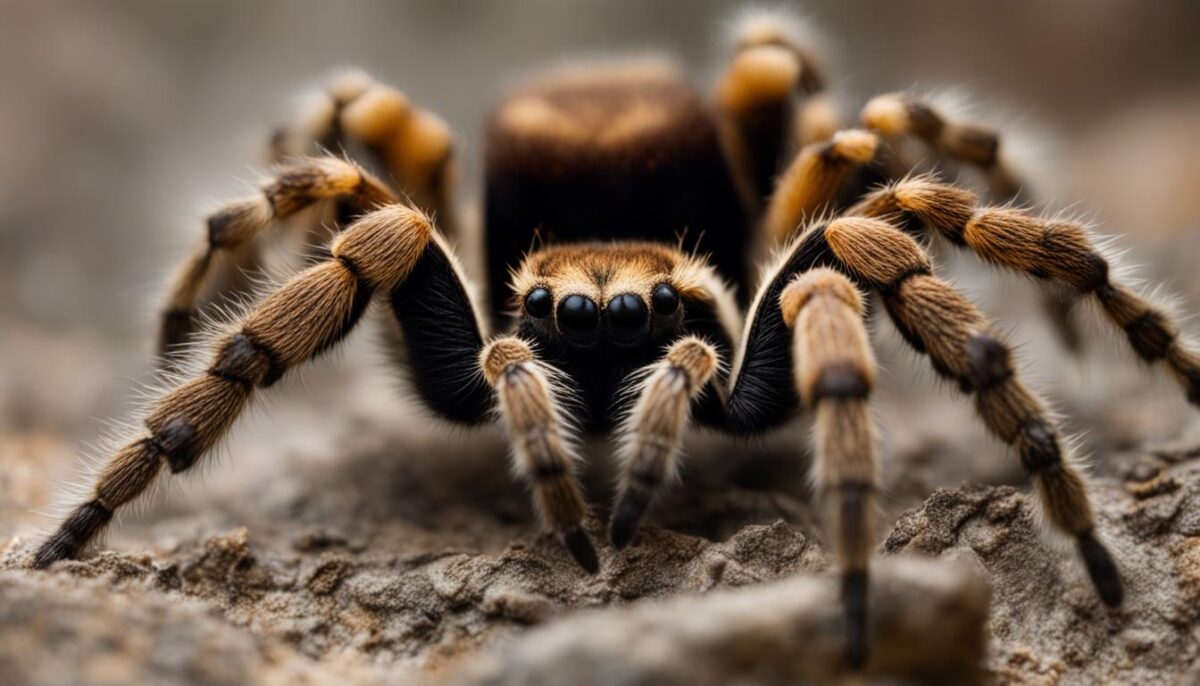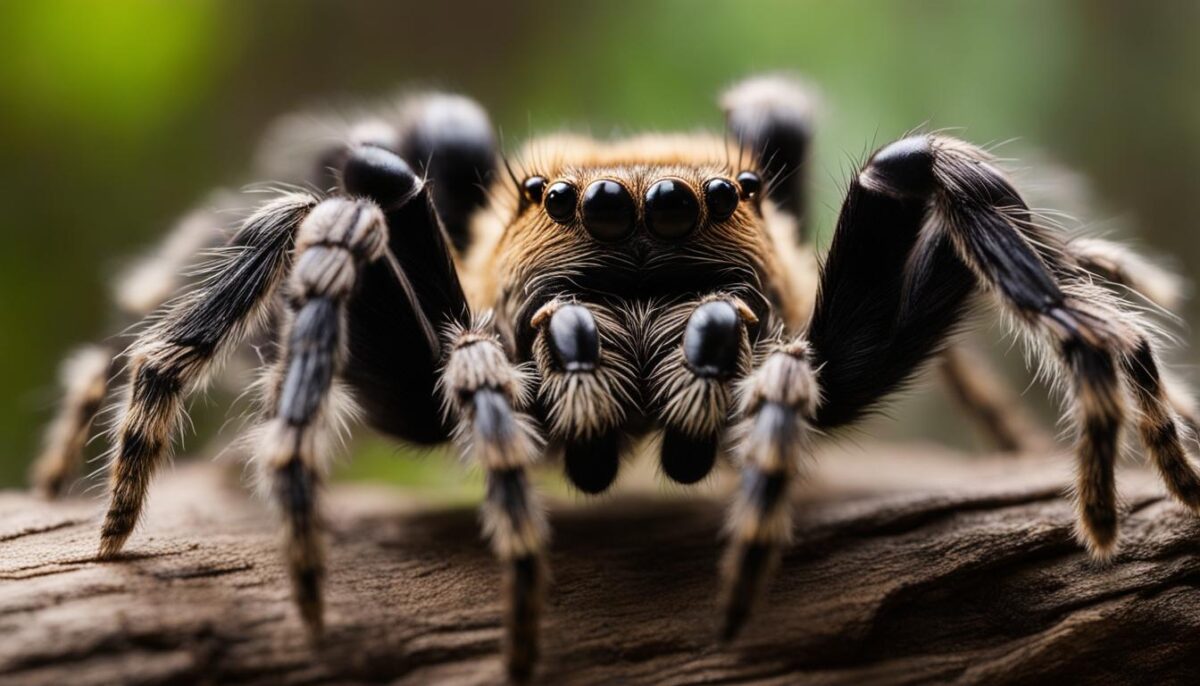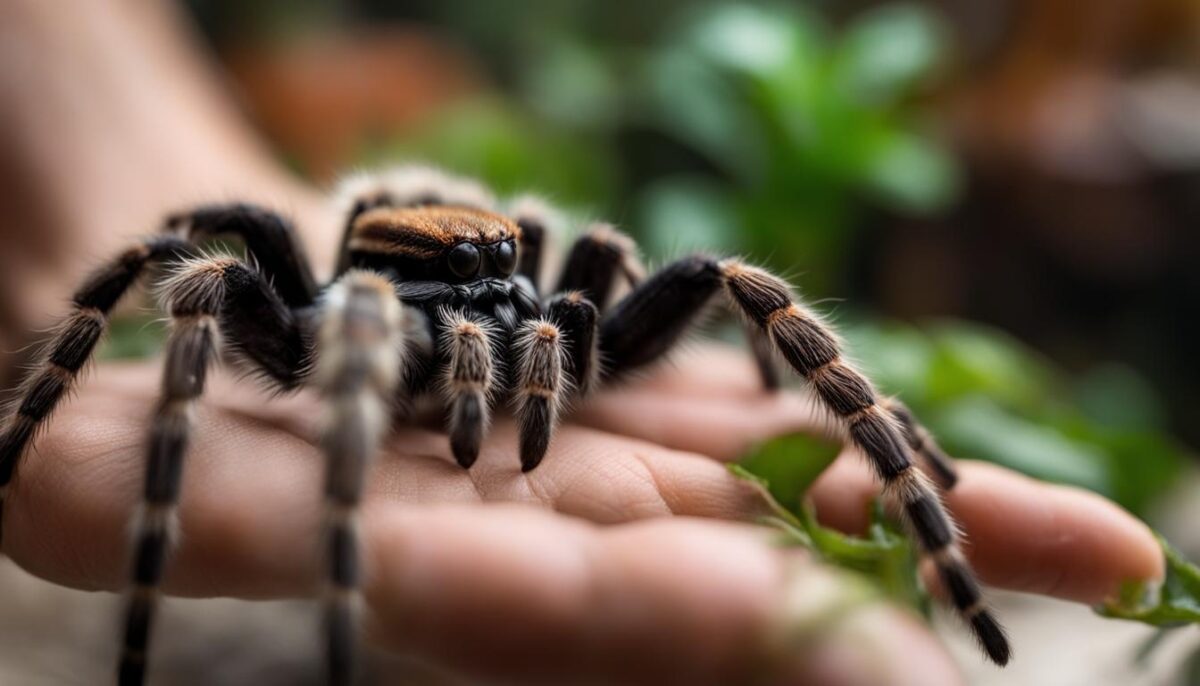Tarantulas are fascinating creatures known for their large size and sometimes feared appearance. Despite their intimidating looks, they have an interesting life span that sets them apart from other spiders. In general, tarantulas pose little threat to humans, and deaths resulting from tarantula bites are extremely rare. While tarantulas are venomous, their venom is usually not potent enough to cause significant harm to humans. The mortality rate from tarantula bites is exceedingly low, with only a handful of documented cases worldwide. It’s important to note that most tarantula species will only bite if they feel threatened, and they typically use their venom as a defense mechanism rather than for hunting or killing prey.
Key Takeaways:
- Tarantulas are generally not dangerous to humans and deaths from tarantula bites are extremely rare.
- The mortality rate from tarantula bites is low, with only a handful of documented cases worldwide.
- Most tarantula species only bite if they feel threatened and use their venom as a defense mechanism.
- Tarantulas are fascinating creatures with unique lifespans and play an important role in the ecosystem.
- Understanding tarantula behavior and practicing responsible interaction can help humans coexist with them safely.
How Many Tarantulas Kill Humans a Year
Tarantula Lifespan Basics
Tarantulas, with their unique characteristics and impressive size, have a fascinating lifecycle. Understanding the lifespan of these creatures can provide valuable insights into their behavior and development. On average, female tarantulas can live up to 20-25 years, while males have a shorter lifespan of 7-8 years. However, it’s important to note that lifespan can vary depending on species, gender, and environmental factors.
Female tarantulas tend to live longer than their male counterparts. In the wild, tarantulas face numerous challenges that can impact their lifespan. Predation, habitat conditions, and the availability of food and water all play a role in determining how long a tarantula will live. These factors highlight the importance of a tarantula’s environment and the need to protect their natural habitats. how many tarantulas kill humans a year
Throughout their lifespan, tarantulas go through various stages of development. Molting is a notable process that involves shedding their exoskeleton to grow larger. Younger tarantulas molt more frequently, while adult tarantulas may only molt once a year. Maturity and reproduction are key milestones in a tarantula’s lifespan, with males typically living for 7-8 years and females up to 20-25 years.
Tarantula Lifespan Basics
| Tarantula Species | Female Lifespan | Male Lifespan |
|---|---|---|
| Mexican Redknee Tarantula | Up to 25 years | Up to 5 years |
| Chilean Rose Hair Tarantula | Up to 15 years | Up to 5 years |
“Tarantulas have a wide range of lifespan depending on their species, gender, and environmental factors.”
Tarantula Lifespan in Captivity vs. The Wild
Tarantulas have the potential to live longer in captivity compared to their lifespan in the wild. When tarantulas are kept in captivity, they benefit from a controlled environment that protects them from natural predators and adverse weather conditions. These factors contribute to an extended lifespan for captive tarantulas.
The average lifespan of a tarantula in captivity can range from 10 to 30 years, depending on the species. Providing a suitable habitat with proper temperature, humidity, and lighting conditions is essential for the well-being and longevity of captive tarantulas. Additionally, offering a balanced diet and ensuring access to fresh water are crucial for their overall health.

However, it’s important to note that captive tarantulas require proper care and attention to thrive. Owners must replicate the tarantula’s natural environment as closely as possible, taking into account factors such as substrate, hiding spots, and other environmental enrichment. Inadequate care or neglect can have detrimental effects on the lifespan and well-being of captive tarantulas.
In contrast, tarantulas in the wild face numerous challenges that can impact their lifespan. These challenges include predation from larger animals, scarcity of food and water, and exposure to harsh weather conditions. As a result, their lifespan in the wild is often shorter compared to their captive counterparts.
Different Tarantula Species and Their Lifespans
Tarantulas, with their diverse species, exhibit varying lifespans. Understanding the lifespan of different tarantula species is essential for tarantula enthusiasts and pet owners. Below are some examples of tarantula species and their respective lifespans:
| Tarantula Species | Female Lifespan | Male Lifespan |
|---|---|---|
| Mexican Redknee Tarantula | Up to 25 years | Up to 5 years |
| Chilean Rose Hair Tarantula | Up to 15 years | Up to 5 years |
| Brazilian Black Tarantula | Up to 20 years | Up to 8 years |
These examples highlight the differences in lifespan between female and male tarantulas. Female tarantulas generally have longer lifespans compared to their male counterparts. However, it’s important to note that these examples represent only a few species, and actual lifespans may vary depending on factors such as habitat conditions, care, genetics, and individual health.
Factors Affecting Lifespan
While the lifespan of tarantulas varies among species, other factors can also influence their overall longevity. Some of these factors include:
- Habitat conditions: Tarantulas living in environments with suitable temperature, humidity, and space tend to have better chances of living longer lives.
- Availability of food: Adequate and regular access to a balanced diet is crucial for a tarantula’s wellbeing and lifespan.
- Genetics: The genetic makeup of an individual tarantula can have an impact on their lifespan.
- Health: Like any living creature, tarantulas can be susceptible to diseases and other health issues that may affect their lifespan.
Understanding these factors and providing the necessary care and environment can help maximize the lifespan of tarantulas in captivity.
Overall, exploring the lifespan of different tarantula species offers valuable insights into their unique characteristics and requirements. By delving into these differences, enthusiasts and pet owners can better understand and appreciate these fascinating arachnids.
Tarantula Lifespan Stages
Tarantulas go through various stages in their lifespan, including molting, maturity, and reproduction. These stages play a significant role in determining the overall lifespan of tarantulas.
Molting
Molting is a crucial process in the life of a tarantula. It is the shedding of their exoskeleton to allow for growth. Younger tarantulas molt more frequently, while adult tarantulas may only molt once a year. During the molting process, the tarantula becomes vulnerable as it sheds its old exoskeleton and waits for the new one to harden. Proper humidity levels and a secure hiding spot are essential during this time to ensure the tarantula’s safety.
Maturity
Maturity is another important stage in a tarantula’s lifespan. This is the point at which the tarantula reaches sexual maturity and is capable of reproducing. Males typically mature faster than females but have a shorter lifespan. Female tarantulas, on the other hand, take longer to reach maturity but can live significantly longer. The age at which tarantulas reach maturity varies depending on the species.
Reproduction
Mating and reproduction are crucial for the continuation of the tarantula species. Male tarantulas take significant risks during the mating process, as females are known to cannibalize their partners in some cases. After successful mating, female tarantulas can store sperm for an extended period, using it to fertilize multiple egg sacs throughout their lifespan. The reproductive phase is an essential part of a tarantula’s life and contributes to its overall lifespan.
| Lifespan Stage | Description |
|---|---|
| Molting | The process of shedding the old exoskeleton to allow for growth. Younger tarantulas molt more frequently, while adults molt less frequently. |
| Maturity | The stage at which a tarantula reaches sexual maturity and is capable of reproducing. Males usually mature faster than females. |
| Reproduction | The process of mating and fertilizing egg sacs. Female tarantulas can store sperm for an extended period and use it to fertilize multiple egg sacs. |
Threats to Tarantula Lifespans
Tarantulas, despite their resilience, face various threats that can impact their lifespans. Natural predators pose a significant danger to these creatures, with larger lizards, snakes, and birds preying on them and shortening their lifespans. The presence of these predators adds a constant pressure on tarantula populations in the wild.
In addition to predation, tarantulas also have to contend with diseases and parasites that can compromise their health and longevity. One of the most notable threats is the parasitic Pepsis wasp, which lays its eggs in paralyzed tarantulas. The hatching larvae then feed on the immobilized spider, causing harm and potentially reducing its lifespan.
“Tarantulas are fascinating creatures that play an important role in the ecosystem.”
It is crucial to understand that these factors significantly limit the lifespan of tarantulas in their natural habitats. The impact of predation, diseases, and parasites can result in reduced lifespans and overall health issues for these arachnids.
| Predators | Diseases | Parasites |
|---|---|---|
| Lizards | Viral Infections | Pepsis Wasp |
| Snakes | Fungal Infections | |
| Birds | Bacterial Infections |
Protecting the natural habitats of tarantulas and raising awareness about the importance of these creatures in the ecosystem is crucial for their conservation. By understanding and addressing the threats they face, we can help ensure the continued survival of these fascinating arachnids.
Interesting Tarantula Facts
Tarantulas, with their venomous reputation and imposing size, are undoubtedly intriguing creatures. Here are some fascinating facts about these arachnids:
- Tarantula Venom: While tarantula venom may cause pain and discomfort to humans, it is generally not life-threatening. These spiders use their venom primarily to immobilize their prey and as a defense mechanism against potential threats.
- Tarantula Size: Tarantulas come in various sizes, with some species being larger than others. The Goliath bird-eating tarantula, for instance, boasts an impressive leg span of up to 11 inches, making it one of the largest tarantula species in the world.
Did you know? Tarantulas are known for their docile nature and are usually not aggressive towards humans. They prefer to retreat or flee rather than engage in confrontation.
Tarantulas can also display a wide range of colors, with some species possessing vibrant hues, while others have more subdued coloration. For example, the Chilean Rose Hair tarantula may have a beautiful rose-colored abdomen, adding to its visual appeal.
It’s essential to appreciate the importance of these arachnids in the ecosystem. While they may instill fear in some individuals, tarantulas play a crucial role in regulating insect populations and maintaining the balance of nature. They are remarkable creatures to observe and study, showcasing unique behaviors and adaptations that have allowed them to survive for millions of years.

| Tarantula Species | Size (Leg Span) | Coloration |
|---|---|---|
| Goliath bird-eating tarantula | Up to 11 inches | Varies; typically brown or black |
| Chilean Rose Hair tarantula | Up to 6 inches | Rose-colored abdomen |
| Mexican Redknee Tarantula | Up to 7 inches | Dark-colored body with bright red knees |
Unraveling the Myth: Tarantulas and Human Deaths
Tarantulas have long been associated with fear and danger due to their intimidating appearance. However, it is important to dispel the myth surrounding tarantulas and human deaths. While tarantulas are venomous creatures, deaths resulting from their bites are extremely rare. tarantula fatalities
The venom of tarantulas is generally not potent enough to cause significant harm to humans. Most tarantula species will only bite if they feel threatened or cornered, using their venom as a defensive mechanism rather than a means of hunting or killing prey. It’s estimated that there are only a handful of documented cases worldwide of human deaths attributed to tarantula bites, highlighting the rarity of such occurrences.
“Tarantulas are fascinating creatures that play an important role in the ecosystem. By understanding their behavior, humans can appreciate their beauty and coexist with them safely.”
It’s crucial to remember that tarantulas are generally shy and non-aggressive creatures. They prefer to avoid human interaction and will usually try to retreat or flee if given the opportunity. With a respectful and cautious approach, humans can minimize the risk of being bitten by a tarantula. tarantula bite fatalities
So, while it’s essential to treat tarantulas with respect and exercise caution when encountering them, the notion of tarantulas causing significant harm or leading to human deaths is largely a myth. These captivating arachnids should be appreciated for their unique characteristics and their role in maintaining the delicate balance of the ecosystem. dangerous tarantulas

The Rare Reality: Tarantula Bite Statistics
| Tarantula Species | Number of Documented Human Deaths |
|---|---|
| Mexican Redknee Tarantula | 3 |
| Chilean Rose Hair Tarantula | 2 |
| Brazilian Black Tarantula | 1 |
Based on available records, only a few tarantula species have been associated with human deaths. The Mexican Redknee Tarantula, Chilean Rose Hair Tarantula, and Brazilian Black Tarantula are among the species with the highest number of documented cases. However, it’s crucial to note that these instances are exceedingly rare and constitute a small fraction of the overall tarantula population. tarantula venom potency
It’s important to approach tarantulas with knowledge and understanding rather than fear. By dispelling myths and misconceptions, we can appreciate these intriguing creatures for what they truly are and foster a harmonious coexistence between humans and tarantulas.
Understanding Tarantula Behavior and Interaction with Humans
Tarantulas, despite their intimidating appearance, are generally shy and non-aggressive creatures. They will usually only bite if they feel threatened or cornered. Tarantulas prefer to avoid human interaction and will typically try to retreat or flee if given the opportunity. It’s important for humans to exercise caution and respect when encountering tarantulas, giving them space and avoiding any actions that may provoke them. By understanding their behavior and practicing responsible interaction, humans can coexist with tarantulas without any significant risks. tarantula mortality rate
Common Tarantula Behaviors
- Tarantulas are nocturnal creatures, meaning they are most active at night.
- They are skilled predators, using their keen sense of touch and motion detection to capture prey.
- Tarantulas have specialized hairs on their abdomens called urticating hairs, which they can use as a defensive mechanism by flicking them at potential threats.
- When threatened, tarantulas may raise their front legs or rear up on their hind legs to appear larger and more intimidating.
- Some tarantula species also have the ability to make hissing or stridulating sounds as a form of communication or warning.
It’s worth noting that tarantulas are not naturally aggressive towards humans. They are solitary creatures that prefer to spend their time hunting for food and maintaining their burrows. Tarantulas typically only bite if they feel their life is in immediate danger, such as being cornered or handled roughly. tarantula human deaths
“Tarantulas have a bad reputation, but they are often misunderstood. They are fascinating creatures that play an important role in controlling insect populations and maintaining ecosystem balance. By respecting their space and observing them from a safe distance, we can appreciate their beauty and unique behaviors without causing harm to either them or ourselves.” – Dr. Jane Wilson, Arachnologist
To safely observe tarantulas in their natural habitat, it’s recommended to keep a respectful distance and avoid making sudden movements or loud noises that could startle them. Tarantulas are generally not a threat to humans, and encounters can be a fascinating opportunity to learn about these incredible arachnids.
| Tarantula Behavior | Interaction with Humans |
|---|---|
| Shy and non-aggressive | Prefer to avoid human interaction |
| Retreat or flee if given the opportunity | May bite if threatened or cornered |
| Nocturnal and active at night | Respect their space and observe from a safe distance |
| Specialized urticating hairs as a defensive mechanism | Avoid making sudden movements or loud noises |
| Some species can make hissing or stridulating sounds | Keep a respectful distance and avoid handling |

Tips for Tarantula Enthusiasts and Pet Owners
If you’re a tarantula enthusiast or considering getting a tarantula as a pet, it’s important to understand their specific care requirements. Tarantulas are fascinating creatures that require a suitable habitat to thrive and live a long and healthy life. Here are some tips to ensure you provide the best care for your tarantula: deadly tarantulas
- Creating the perfect habitat: Tarantulas need a well-designed and secure enclosure that mimics their natural environment. Use a terrarium with proper ventilation and ensure it is escape-proof. Opt for a substrate like coconut fiber or peat moss, which allows for burrowing. Provide hiding spots such as cork bark or hollow logs to give your tarantula a sense of security.
- Temperature and humidity: Maintaining the right temperature and humidity levels is crucial for tarantulas. Research the specific needs of your tarantula species and make necessary adjustments. Use a thermometer and hygrometer to monitor the temperature and humidity in the enclosure. Mist the enclosure regularly to maintain the required humidity.
- Feeding and nutrition: Tarantulas are carnivorous and feed on live prey. Offer a varied diet that includes appropriate-sized insects like crickets, mealworms, and roaches. Feed your tarantula once or twice a week, depending on its size and species. Remove any uneaten prey to prevent spoilage and maintain cleanliness.
- Handling and interaction: Tarantulas are not creatures that crave human interaction. It’s important to minimize handling and only do so when necessary. When handling your tarantula, be gentle, avoid sudden movements, and support its entire body to prevent injury. Wash your hands before and after handling to prevent the transfer of any chemicals or substances that could harm your tarantula.
Remember, each tarantula species may have unique care requirements, so it’s essential to research and understand the specific needs of your tarantula. Consult with experts, join tarantula enthusiast forums, and learn from experienced owners to ensure you provide the best care for your tarantula companion. tarantula attacks on humans

By following these tips and providing a suitable habitat, proper nutrition, and minimal handling, you can ensure your tarantula thrives and lives a long and healthy life. Tarantulas are captivating creatures, and with the right care, they can be fascinating pets that bring joy and intrigue into your life. tarantula bite statistics
Conclusion
Tarantulas, with their intimidating appearance, have often been misunderstood and feared. However, it’s crucial to recognize that deaths resulting from tarantula bites are extremely rare. Their venom, while venomous, is not typically potent enough to cause significant harm to humans. Tarantulas play a vital role in the ecosystem and should be appreciated as fascinating creatures rather than feared as deadly creatures.
Understanding the behavior of tarantulas is essential in ensuring a safe and respectful interaction with these creatures. They are generally shy and non-aggressive, preferring to retreat or flee rather than engage in conflict. By giving them space and avoiding actions that may provoke them, humans can coexist with tarantulas without significant risks.
For those interested in keeping tarantulas as pets, it is important to research and understand their specific care requirements. Providing a suitable habitat, proper temperature and humidity levels, and a varied diet are essential for the well-being and longevity of pet tarantulas. Responsible pet ownership and seeking guidance from experts or experienced tarantula enthusiasts can ensure a fulfilling and safe experience.
Overall, tarantulas should be appreciated for their fascinating characteristics and ecological importance. While their formidable appearance may be unsettling, it’s important to remember that they pose little threat to humans. By fostering understanding, respect, and responsible interaction, humans can peacefully coexist with these captivating arachnids.
FAQ
Are tarantulas dangerous to humans?
No, tarantulas are generally not dangerous to humans. Deaths resulting from tarantula bites are extremely rare, and their venom is not typically potent enough to cause significant harm.
How long do tarantulas live?
The lifespan of tarantulas varies depending on the species, gender, and environmental factors. On average, females can live up to 20-25 years, while males have a shorter lifespan of 7-8 years.
Do tarantulas live longer in captivity or the wild?
Tarantulas can live longer in captivity compared to the wild. The average lifespan of a captive tarantula can range from 10 to 30 years, depending on the species.
What are the lifespans of different tarantula species?
Tarantula species have varying lifespans. For example, the Mexican Redknee Tarantula has a female lifespan of up to 25 years and a male lifespan of up to 5 years. The Chilean Rose Hair Tarantula, on the other hand, has a female lifespan of up to 15 years and a male lifespan of up to 5 years.
What stages do tarantulas go through in their lifespan?
Tarantulas go through stages such as molting, maturity, and reproduction. Younger tarantulas molt more frequently, while adult tarantulas may molt once a year. Maturity and reproduction play a significant role in their lifespan.
What are the threats to tarantula lifespans?
Tarantulas face threats from natural predators, diseases, and parasites. Predators such as lizards, snakes, and birds can prey on them. The parasitic Pepsis wasp is a significant threat as it lays eggs in paralyzed tarantulas, feeding on them.
What are some interesting facts about tarantulas?
Tarantulas have venom used to immobilize prey, but it is generally not life-threatening to humans. They come in various sizes and colors, with species like the Goliath bird-eating tarantula being the largest, with a leg span of up to 11 inches.
How many human deaths result from tarantula bites?
Deaths resulting from tarantula bites are extremely rare. Only a handful of documented cases exist worldwide.
Are tarantulas aggressive towards humans?
Tarantulas are generally shy and non-aggressive creatures. They will usually only bite if they feel threatened or cornered. They prefer to retreat or flee when given the opportunity.
What tips do you have for tarantula enthusiasts and pet owners?
It’s important to provide a suitable habitat with proper temperature and humidity levels, access to fresh water, and hiding spots. Clean and secure enclosures, appropriate substrate, and a varied diet are crucial for their well-being and longevity.

